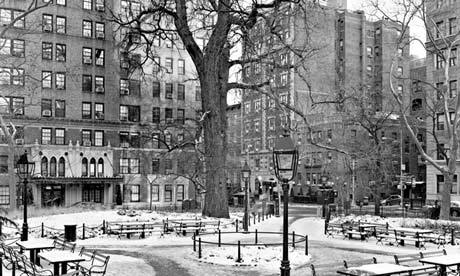Mitch Epstein's photographs of New York trees are a wonderful reminder of nature's place in the metropolis


The English Elm in Washington Square park, New York, known as the Hangman’s Elm. Photograph by Mitch Epstein/Steidl
Formost of 2011 Mitch Epstein wandered the five boroughs of New York in search of trees. Following on from his epic series, American Power, which focused on the looming architecture of oil and gas, this smaller, more local project was, he writes, "about photographing something to honour, rather than mourn". It is also about looking and seeing; about the way nature, resilient, enduring, can go almost unnoticed in a big city.
New York Arbor is a book of black and white photographs of city trees, both native and imported: cottonwoods, cypresses, beeches, elms, lindens, maples, sycamores and willows. Epstein mentions two touchstones for the project: Eugène Atget, who photographed trees in Paris in the early 20th century, and Robert Adams, who has recorded the decimation of native forests in the Pacific Northwest over the past few decades.
Here, though, the tone is more reflective. Epstein makes you see, not just the trees on the streets and parks of New York, but their often unnoticed presence in the city. Many's the time I have sat under the English elm in Washington Square park without knowing that it was nicknamed the Hangman's Elm (because, legend has it, it was where revolutionary war traitors were hanged). Who knew, too, that Brooklyn can boast a caucasian wingnut, or Queens a beautiful tulip tree, or the Bronx a spreading white oak?
Epstein's gaze is democratic. He allows each tree its own space – and place – whether in a park, a street or protected in a botanic garden. He shows how they become features in an urban landscape of concrete and steel, towering above suburban house in Queens and Long Island or fighting for light amid the tall towers of Manhattan. Certain trees have become almost totemic: the ancient and colossal tulip tree in residential Queens known as the Alley Pond Giant; the leaning American elm on Eastern Parkway, Brooklyn, supported by a solid block of reinforced concrete; the ancient English elm on St Nicholas Avenue in upper Manhattan whose branches need steel cable to keep them from falling.
A bald cypress on a suburban street in Queens looks marooned and forlorn, while an eastern white pine in Owl's Head park in Brooklyn lends the setting an elemental aspect. You can see how trees – and even a single tall tree – can change the atmosphere of a neighbourhood. Drug dealers congregate by the English Elm in Washington Square, peddling their dime bags as if camouflaged by its foliage.
These New York trees are metaphorical, too. "Despite their swampy or mountainous or tropical origins," writes Epstein "these immigrant trees, alongside their native counterparts, still thrive in New York City. The trees remind me of the human immigrants who continually arrive in New York, who creatively adapt to a brutal yet tolerant city, and rarely abandon their original character."
New York Arbor is published in the UK on 1 June
New York Arbor is a book of black and white photographs of city trees, both native and imported: cottonwoods, cypresses, beeches, elms, lindens, maples, sycamores and willows. Epstein mentions two touchstones for the project: Eugène Atget, who photographed trees in Paris in the early 20th century, and Robert Adams, who has recorded the decimation of native forests in the Pacific Northwest over the past few decades.
Here, though, the tone is more reflective. Epstein makes you see, not just the trees on the streets and parks of New York, but their often unnoticed presence in the city. Many's the time I have sat under the English elm in Washington Square park without knowing that it was nicknamed the Hangman's Elm (because, legend has it, it was where revolutionary war traitors were hanged). Who knew, too, that Brooklyn can boast a caucasian wingnut, or Queens a beautiful tulip tree, or the Bronx a spreading white oak?
Epstein's gaze is democratic. He allows each tree its own space – and place – whether in a park, a street or protected in a botanic garden. He shows how they become features in an urban landscape of concrete and steel, towering above suburban house in Queens and Long Island or fighting for light amid the tall towers of Manhattan. Certain trees have become almost totemic: the ancient and colossal tulip tree in residential Queens known as the Alley Pond Giant; the leaning American elm on Eastern Parkway, Brooklyn, supported by a solid block of reinforced concrete; the ancient English elm on St Nicholas Avenue in upper Manhattan whose branches need steel cable to keep them from falling.
A bald cypress on a suburban street in Queens looks marooned and forlorn, while an eastern white pine in Owl's Head park in Brooklyn lends the setting an elemental aspect. You can see how trees – and even a single tall tree – can change the atmosphere of a neighbourhood. Drug dealers congregate by the English Elm in Washington Square, peddling their dime bags as if camouflaged by its foliage.
These New York trees are metaphorical, too. "Despite their swampy or mountainous or tropical origins," writes Epstein "these immigrant trees, alongside their native counterparts, still thrive in New York City. The trees remind me of the human immigrants who continually arrive in New York, who creatively adapt to a brutal yet tolerant city, and rarely abandon their original character."
New York Arbor is published in the UK on 1 June
No comments:
Post a Comment